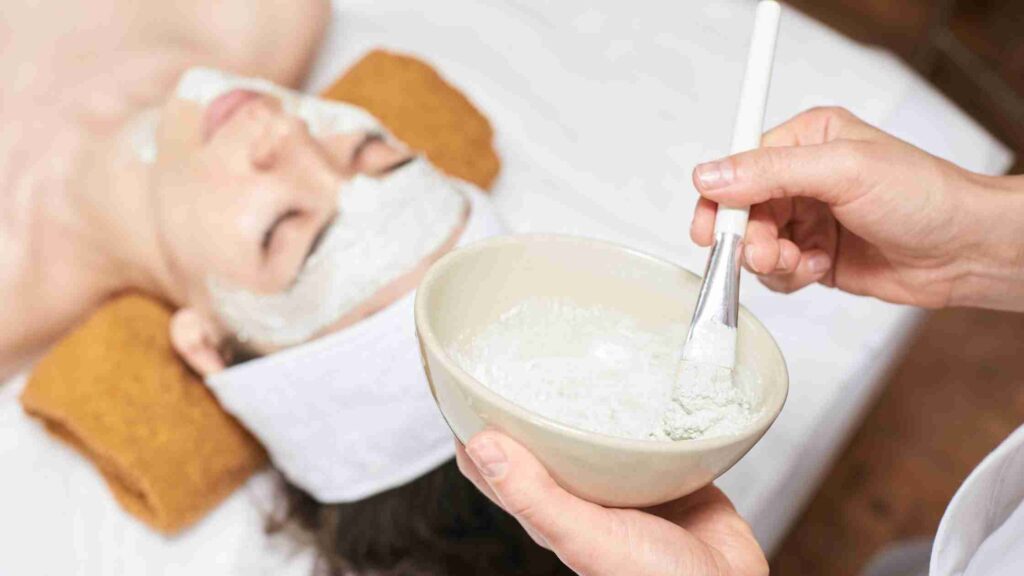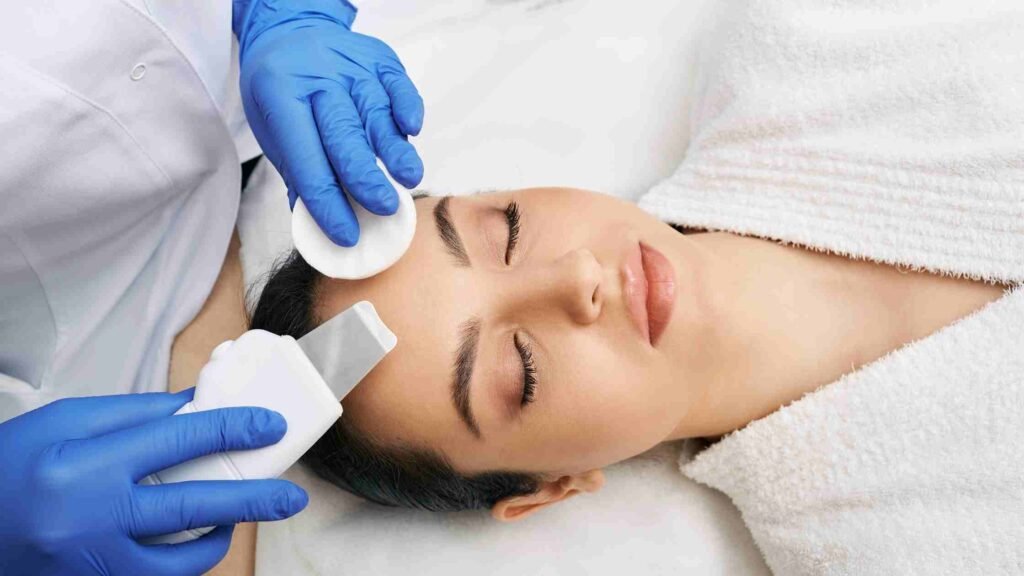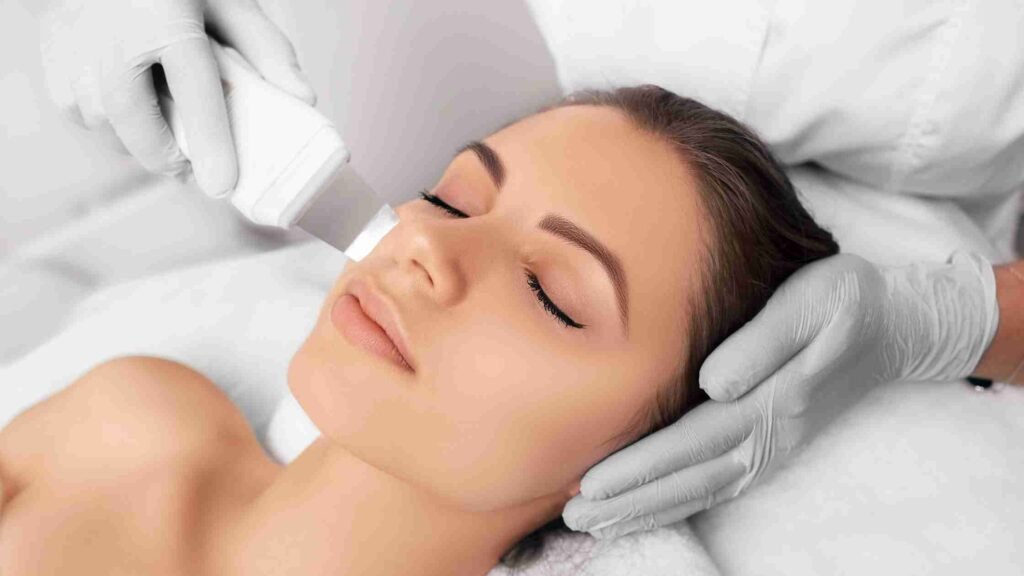If acne-free skin is the goal, there are about 1000 ways to achieve that. But one that seems to be one of the safest and universal favorites is chemical peels. Chemical peel treatment is a non-invasive treatment modality that targets a wide range of skin issues and improves general skin properties. And we can bet on the fact that in 2022 chemical peel is arguably one of the most efficient skin treatments one can get for acne.
When it comes to chemical peel for acne treatment, there is no single chemical peel that effectively fits every patient’s treatment plan. Lactic acid, glycolic acid, and salicylic acid are the most commonly used chemical peels. Glycolic acid peel is the most preferred one for treating acne and acne scars for being a potent component to diminish and potentially eliminate acne problems and to improve the general state and appearance of the skin.
Read more about What Is Acne Rosacea- Causes, Symptoms, Treatment Options & More
This article will discuss glycolic acid peel, including which conditions can cause glycolic acid peel to treat alongside treating acne and acne scars. We will also take your glance at other chemical peel options to deal with acne.

We will discuss every detail so that you can educate yourself about glycolic acid peel and make an informed decision on whether or not glycolic acid peel is suitable for you.
What Is Glycolic Acid?
Glycolic acid is an odorless and colorless acid known as hydroxyacetic acid. It is highly soluble in water and is used in various skin care products. Glycolic acid has a widespread presence in nature.
The term ‘glycolic acid’ was first introduced in 1848 by French chemist Auguste Laurent. According to him, the amino acid glycine, which was then called glycocoll, might be the amine of the acid called glycolic acid.
In 1851 German chemist Adolph Stracker first prepared glycolic acid along with a Russian chemist Nikolai Nikolaevich. They treated hippuric acid with nitrogen dioxide and nitric acid to form an ester of glycolic acid and benzoic acid. And they named the compound derived benzo glycolic acid. Later they boiled the ester for several days with dilute sulphuric acid to obtain benzoic acid and glycolic acid.
There are several ways of synthesizing glycolic acid. And the most used approach is by using a catalyzed reaction of formaldehyde and synthesis gas to prepare glycolic acid cost-effectively.
Another approach of glycolic acid preparation is by the reaction of sodium hydroxide and chloroacetic acid followed by re-acidification. However, many other methods are not in use.
Read more about How To Reduce Body Heat Pimples
What Are The Properties Of Glycolic Acid?
If we compare glycolic acid and acetic acid, glycolic acid is a little more vital, given the electron-withdrawing power of the terminal hydroxyl group. The carboxylic group can coordinate with metal ions to form coordination complexes. Those complexes are significantly more potent than those with other carboxylic acids, which indicates that the hydroxyl group involves complex formation, probably with the loss of its proton.

What Is Glycolic Acid Peel?
Glycolic acid peels have been time tested and are here to stay in the skin care industry for being highly popular amongst dermatologists for various procedures. It is an alpha hydroxy acid peel, also known as a fruit peel. Studies on glycolic acid peels have established the solution to be a simple, inexpensive, and effective treatment modality for acne scars, melasma, hyperpigmentation, photoaging, and more with no downtime.
Glycolic acid peel is a medium-depth peel with therapeutic and cosmetic benefits for our skin. Glycolic acid obtained from sugarcane is the most commonly used alpha hydroxy acid peel in the cosmetology industry today.
Among all the alpha hydroxy acids, glycolic acid has the most negligible molecular weight, penetrating the skin quickly. There are two carbon atoms in glycolic acid: one with a carboxyl group and the other with a hydroxyl group.
Read more about Best Treatment Modalities for Nodular Acne
Glycolic acid peels are commonly available as free acids. Most of them are partially neutralized or buffered. And there are various concentrations available for glycolic acid from 20% to 70%. When the concentration of glycolic acid peel rises, the pH gets lower, and the more intense the peel becomes.
Use Of Glycolic Acid Peel For Acne And Acne Scars
Chemical peels are used to exfoliate our skin. When professionally done, the chemical peels come in 3 strengths: mild, medium, and deep. Glycolic acid peels are considered to be gentle peel, yet it has the power to slough off the surface and the middle layers of the skin, removing debris and dead skin cells.
As mentioned earlier, the glycolic acid peel can penetrate the skin, removing the lipids that hold dead skin cells together. The percentage of the glycolic acid concentration determines how deeply the acid will penetrate the skin layers. Glycolic acid also extracts excess oil from the hair follicles, which is why glycolic acid peel is an effective solution for treating acne.
It also reduces the production of melanin, which is beneficial for reducing dark spots.
When your skin has acne problems, and glycolic acid peel is applied, it works by breaking down the bonds between the outer layer of your skin cells, including the dead skin cells, and the very next skin cell layer. It creates a peeling effect and makes your skin appear even and smoother.
Glycolic acid also opens clogs in the pores and clears out the skin, leading to fewer breakouts in an individual suffering from acne. Glycolic acid also significantly impacts the outer skin barrier and helps retain moisture instead of drying it out. This is advantageous for people with acne-prone skin because other topical anti-acne agents like benzoyl peroxide and salicylic acid dry out the skin.
According to a study performed in 2018, it was found that glycolic acid has antioxidant and antibacterial activity that helps improve the appearance of your skin when you are suffering from acne problems. And it also stimulates collagen growth and thickens the skin.
Read more about How To Get Rid Of Milia Bumps?
Who Should Try A Glycolic Acid Peel?

If your skin has severe acne problems alongside hyperpigmentation, fine lines, and wrinkles, glycolic acid peel would be the best treatment for you. Glycolic acid peel is a potent exfoliant. It can visibly reduce the appearance of acne by weakening the connections that cells in the top layer of our skin, removing the dead skin cells, and giving your skin a refreshed and glowing look. But the glycolic acid peel might take some time to work on acne and acne scars.
However, even though you have active acne, you can still go for glycolic acid peel, as the antibacterial effects of the peel can diminish the impact of the bacteria responsible for inflammatory acne.
Suppose you have a sensitive skin type or suffering from conditions like rosacea or eczema. In that case, it is essential to talk to your dermatologist before getting a glycolic acid peel done since it can be a little more irritating than other chemical exfoliants. Your doctor might choose a milder glycolic acid concentration or figure out other treatment options in those cases.
Read more about Everything You Need to Know About Skin Polishing Treatment
How Is Glycolic Acid Chemical Peel Done?
Glycolic acid peel is generally done in your dermatologist’s office since it is a mild peel. Before the procedure, your dermatologist will likely ask you to tie your hair back. Before applying the peel on your face, the dermatologist will clean your face and provide you with a pair of protective goggles to protect your eyes during the procedure.
In some patients who are intolerant to chemical peels, the doctor might numb the area with a topical anesthetic, but this is mainly done when they receive a deep peel or glycolic acid in a high concentration. For a high concentration of glycolic acid peel, your doctor may also use regional anesthetic on large areas, especially when treating your face or neck.
How To Prepare For A Glycolic Acid Peel Session?
Before starting a chemical peel treatment, you must consult with a skincare specialist. During your visit to their clinic, they will determine the best glycolic acid concentration for your skin. They will inform you about the specific peel in detail, and they can ask you questions about things that can interfere with the peel. The queries might include whether you are taking any acne medication and information about whether you are prone to getting acne scars quickly.
Before going for a glycolic acid peel, you must:
- Avoid using any retinal or Retin A topical solutions for at least 48 hours
- Inform your dermatologist about the medications you have taken (if any)
Your doctor might also suggest you:
- Take antiviral medication if you likely have fever blisters, cold sores, or a breakout around the mouth.
- Use topical solutions to improve the result of the treatment, like a glycolic acid lotion.
- Use a retinoid cream to prevent your skin from darkening
- Avoid waxing or depilating a week before the peel treatment, alongside avoiding bleaching.
- Avoid using facial scrubs at least one week before the peel treatment
- Arrange a ride home, especially when using glycolic acid peel in a high concentration.
If your doctor asks you to take any oral medication or suggests a painkiller or sedative, you must take it according to their instructions. You will likely have oral medications before arriving at the dermatologist’s office.
Read more about Skin Pigmentation and the Best Possible Treatments
What To Do After A Glycolic Acid Peel Session?
Once your chemical peel treatment with glycolic acid has been completed, your dermatologist or skin therapist will suggest a few things regarding the post-care regimen to treat your skin well. Their instructions might include:
- Use water at room temperature to wash your skin for the next 24 hours.
- Apply a good spectrum sunscreen every day for at least 20 minutes before stepping out in the sun and reapplying the sunscreen every 3 to 4 hours to upkeep its effects.
- Restrain from heavy workouts in the gym, Zumba, or aerobics to avoid excessive sweating
- Not applying makeup for at least 24 hours after the treatment.
- Avoid sauna, hot tubs, and swimming for at least three days after the treatment.
- Indulging in any parlor activities such as threading, facials, and vaccine for the next three days
- Avoid using homemade face packs and scrubs for at least 2 to 3 days after the peel session.
The Concentrations Of Glycolic Acid Used To Treat Acne
There are three significant types of glycolic acid peels, and they differ based on the concentration of the acid in the product being used and the time it stays on your skin.
Read more about How to reduce melanin?
Here is what you can expect from each level of glycolic acid peel:
Light:
A light glycolic acid peel is also called are superficial peel that contains 20% to 30% glycolic acid and is applied for just a few minutes. This peel is used to peel the surface layer of the skin, and it is helpful for mild acne and some hyperpigmentation. There is no downtime associated with a light glycolic peel, but you should abide by all the instructions from your dermatologist to give your skin some time to recuperate.
Medium:
A medium glycolic acid peel may contain up to 50% of glycolic acid, and your doctor might suggest keeping the peel on your face for 2 to 5 minutes. Soon after applying the glycolic acid peel, it penetrates the papillary dermis, which is present in the upper layer of the dermis and sits below the epidermis. Alongside treating moderate acne, the medium-depth glycolic acid peel is also beneficial for treating melasma and hyperpigmentation, improving your skin’s overall texture. However, your skin might experience a downtime of about a week, and you must abide by all the instructions from your dermatologist.
Deep:
Deep glycolic acid peels contain up to 70% of glycolic acid and can be applied for 3 to 15 minutes. Glycolic acid peels in deep concentration can penetrate the reticular dermis, which is present in the lower level of the dermis below the papillary dermis. Deep peels have all the potential that medium-depth peels can do and improve the appearance of acne scars. Deep glycolic acid peel might also require downtime of up to 2 weeks. Deep glycolic acid peel is usually reserved to treat severe acne problems, including infection risk and studying.
Any glycolic acid peel with a concentration above 70% is considered too high even when it stays on your skin for one minute. However, remember that your dermatologist is the sole decider of the time for how long the peel stays on your skin and the glycolic acid peel treatment procedure. You can work closely with your doctor to decide which depth of the glycolic acid peel is correct for you.
What Are The Side Effects Of Glycolic Acid Peel?
There is no life-threatening or severe side effect of glycolic acid peel. The most common side effects include irritation, discoloration of the skin, and redness. But the potential side effects depend upon the depth of the peel and your skin type. After using a light or medium peel, your skin will likely feel tight and have mild redness. After 2 to 3 days, you might notice some dryness or shedding of your skin.
When done wrongly, deeper peels can lead to more severe side effects, including infections and scarring. However, all the possible side effects of glycolic acid peel treatment can be avoided by choosing the right dermatologist with years of experience in chemical peel treatments.
How Often Should You Go For A Glycolic Acid Peel Treatment?
The dermatologist suggests doing multiple peel sessions, usually between 3 and 6 treatments, for the best results. But the number of sessions you require depends on your desired results and budget. Chemical peels cost somewhere between ₹1500 to ₹3000 per session, and the cost goes up when you do multiple treatments.
It is also good to remember that insurance does not cover glycolic acid peel treatment. That makes it essential to consider before you decide on a treatment regimen with your dermatologist for your unique skin needs. However, you must also discuss the recovery time and all the possible side effects and complications.
FAQs About Glycolic Acid Peel
Since glycolic acid peel is an acid no matter where it is derived, people have many questions about it before they go for their first chemical peel session. Here are the most common questions and their answers regarding glycolic acid peel.
Does Glycolic Acid Peel Lighten The Skin?
No, the glycolic acid peel is not associated with skin lightening. Therefore you cannot expect lightening or whitening of your skin after a glycolic acid peel treatment. However, glycolic acid has the potential to fade away dark spots and hyperpigmentation, which makes it a safe ingredient to make your complexion even and brighten your skin tone.
Can I See Result After A Glycolic Peel Session?
In many cases, people see a significant improvement in the appearance of their skin complexion and texture soon after one chemical peel treatment with glycolic acid. This is because glycolic acid peel works as an exfoliant that can drastically improve the quality of your skin superficially, making it look even and soft.
What Does The Glycolic Acid Peel Do?
Glycolic acid peels effectively treat acne, pimples, blackheads, and whiteheads. They also significantly reduce the size of your pores, and consistent and repeated use of glycolic acid peel can effectively remove cystic lesions and acne scars from your skin.
How Long Should I Leave Glycolic Acid On My Face?
G glycolic acid peels can be left on your skin for 3 to 10 minutes. However, depending upon the concentration of the glycolic acid, your dermatologist may decide the time for how long the people will stay on your face.
Can I Get A Glycolic Acid Peel Done At Home?
Many glycolic acid peels are available in the market, and people are safely using those products at home for exfoliation. However, suppose you suffer from skin problems such as acne, hyperpigmentation, etc. In that case, it is better to talk to a dermatologist since they can suggest the right concentration and treat you professionally to reverse your skin condition.
What Happens When I Leave Glycolic Acid On My Face For Too Long?
The wrong usage of glycolic acid peel can damage the collagen and the layers of your skin. It can thicken your skin and cause paleness and dullness to your skin.
Conclusion
Glycolic acid chemical peels are the safest cosmetic treatment when professionally done. And it can treat various skin conditions, including acne and acne scars. Medium and deep-strength glycolic acid peels are best done by board-certified dermatologists or by a licensed aesthetician. However, milder peels can be purchased and used at home but always be sure to find the ones from a reputable company or consult your dermatologist before taking that plunge. I hope this article helps you know everything about glycolic acid peel, including its benefits, ways of usage, and more. For many such articles, keep following us.
